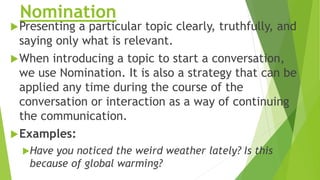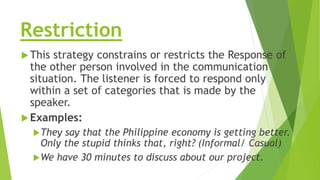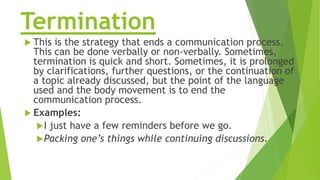COMMUNICATION STRATEGIES.pptx
- 1. COMMUNICATION STRATEGIES CENON EDSEL G. GAYTOS
- 2. Communication Strategies ?Conversations are bound by implicit rules. ?These are plans, or means, of sharing information which are adopted to achieve a particular social, political, psychological, or linguistic purpose.
- 3. Nomination ?Presenting a particular topic clearly, truthfully, and saying only what is relevant. ?When introducing a topic to start a conversation, we use Nomination. It is also a strategy that can be applied any time during the course of the conversation or interaction as a way of continuing the communication. ?Examples: ?Have you noticed the weird weather lately? Is this because of global warming?
- 4. Small Talk ? noun 1. It is a polite conversation about unimportant or uncontroversial matters, especially as engaged in on social occasions. (Oxford Language Dictionary) 2. Small talk is an informal type of discourse that does not cover any functional topics of conversation or any transactions that need to be addressed. (Wikipedia) 3. Small talk is light, informal conversation. It¡¯s commonly used when you¡¯re talking to someone you don¡¯t know very well and at networking and social events. (Frost, 2019)
- 5. Starting a Small Talk
- 6. Restriction ?This strategy constrains or restricts the Response of the other person involved in the communication situation. The listener is forced to respond only within a set of categories that is made by the speaker. ?Examples: ?They say that the Philippine economy is getting better. Only the stupid thinks that, right? (Informal/ Casual) ?We have 30 minutes to discuss about our project.
- 7. Turn-taking ? This strategy requires that each speaker speaks only when it is his/ her turn during an interaction. Knowing when to talk depends on watching out for the verbal and non-verbal cues that signal the next speaker that the previous speaker has finished or the topic under discussion has been exhausted and a new topic may be introduced. ? At the same time, it also means that the others should be given the opportunity to take turn. This strategy uses either formal (permission to speak is requested) or informal approach (just jump in and start taking).
- 8. Examples: ?What do you think about their statement? ?You wanted to say something? ?Thank you for the opportunity to speak. I agree with you. But may I just point out that there are also risks involved when you just go about killing people without due process, may they be drug addicts or not. ?May I have the floor, sir? The topic under discussion is the state of the Philippine economy today.
- 9. Topic-Control ?This is simply a question-answer formula that moves a discussion forward. This also allows the listeners to take turns, contribute ideas, and continue the discussion. ?Topic control covers how procedural formality or informality affects the development of a topic in a conversation.
- 10. Examples ?Yes. ?Okay. ?Go on. ?You agree with the speaker, don¡¯t you? ?How often do you ride the PUJ (jeepney)? How uncomfortable do you find it? ?So, if you leave with your boyfriend, what are you going to do next?
- 11. Topic Shifting ? Topic Shifting is a strategy that is useful in introducing a new topic. This strategy works best when there is a follow-through so that the new topic continues to be discussed. ?Examples: ?I definitely agree with your points. Plus, Beth should have come yesterday if she was serious in helping us. By the way, what have you done with your assignment in Gen. Math?
- 12. Repair ? This strategy is an attempt to correct or fix a communication process that is on the verge or is already broken. There are various means to go about this: ? Repeating: repeating the words so the listener can hear them again. ? Recasting: changing the form of the message (or rewording) to make them more understandable. ? Adding: adding more words to a previous statement. ? Requesting clarification
- 13. Repeating I said ¡°What is your name?¡± Recasting USS Ford is COLOSSAL. USS Ford is really, really big! Adding USS Ford is colossal. I mean, it practically carries over 90 aircrafts! Requesting clarification Can you please clarify what you said?
- 14. Termination ? This is the strategy that ends a communication process. This can be done verbally or non-verbally. Sometimes, termination is quick and short. Sometimes, it is prolonged by clarifications, further questions, or the continuation of a topic already discussed, but the point of the language used and the body movement is to end the communication process. ? Examples: ?I just have a few reminders before we go. ?Packing one¡¯s things while continuing discussions.
- 16. Assessment 1. Hey, how are you? I missed you! 2. I think we should speak one at a time. 3. I am sorry but I have to go now. 4. It is hard to decide on that now. Let us go back to this topic next meeting. Meanwhile, shall we proceed to the next agenda? 5. Do you have anything to say?
















